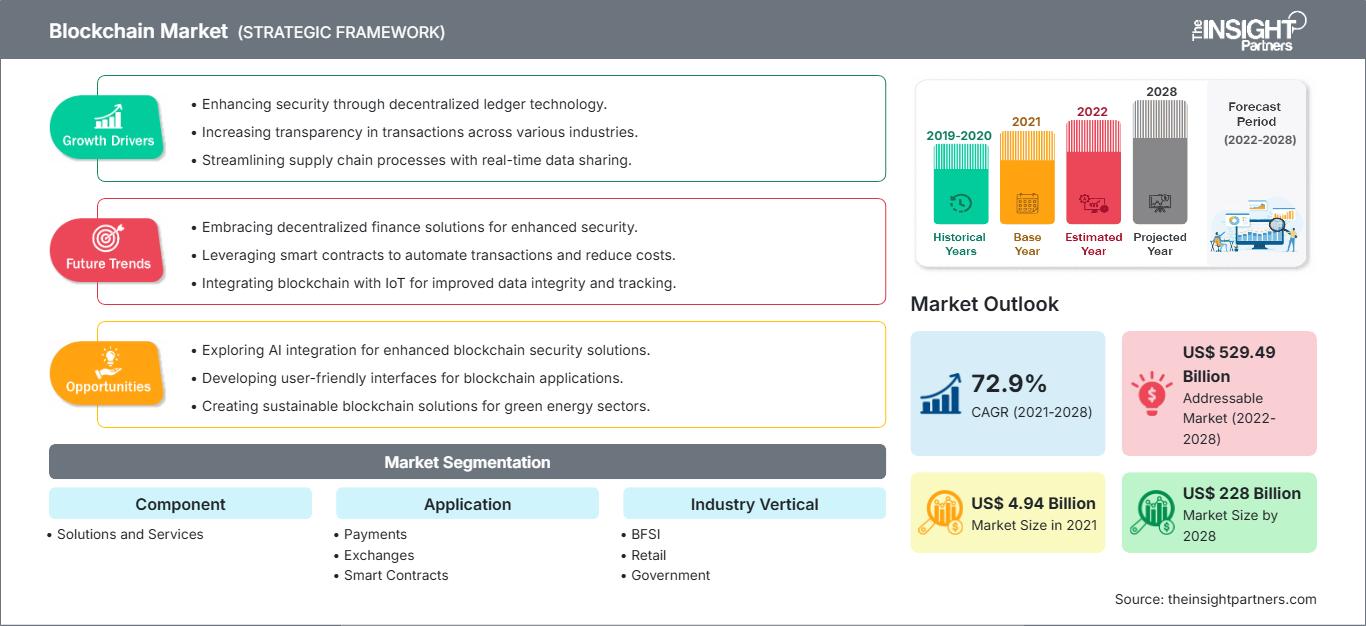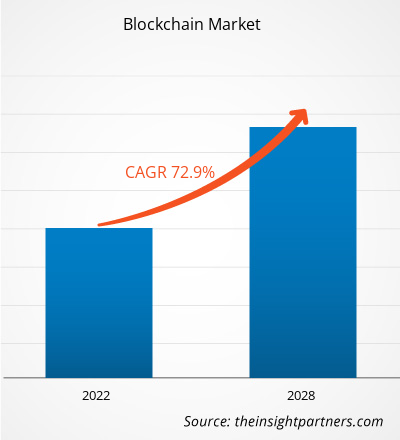Se prevé que el mercado de blockchain crezca de 4.935 millones de dólares en 2021 a 227.996,6 millones de dólares en 2028, con una tasa de crecimiento anual compuesta (TCAC) estimada del 72,9 % entre 2021 y 2028.
La tecnología blockchain y sus aplicaciones en el sector bancario, financiero y de seguros (BFSI) han atraído gran atención en los últimos años, principalmente por su capacidad para transformar los fundamentos y modelos de negocio de las industrias existentes. Actualmente, además de las aplicaciones de criptomonedas, las principales aplicaciones prácticas de blockchain se encuentran en el sector bancario y financiero; sin embargo, diversas empresas e instituciones están desarrollando rápidamente soluciones basadas en blockchain para resolver problemas empresariales complejos. En términos generales, blockchain es un subconjunto de la tecnología de registro distribuido (DLT), que combina tres conceptos clave: criptografía, contratos inteligentes y diseño de registro distribuido. La tecnología de registro distribuido (DLT) es un enfoque emergente que registra y comparte datos en diversos almacenes o registros de datos. La tecnología de registro distribuido (DLT) facilita el registro, el intercambio y la sincronización de transacciones y datos a través de una red distribuida de diferentes participantes.
Se prevé que el mercado global de Blockchain experimente un crecimiento muy elevado en el futuro próximo. Entre los principales factores que impulsan este crecimiento se encuentran la amplia adopción de soluciones Blockchain en el sector BFSI (Banca, Servicios Financieros y Seguros); ventajas como una mayor transparencia, una mayor eficiencia operativa y un ahorro de costes sustancial; y el aumento del número de startups innovadoras. Durante el periodo de previsión, se espera que tendencias como el creciente apoyo e iniciativas gubernamentales y la combinación de Blockchain e inteligencia artificial para aplicaciones avanzadas ofrezcan oportunidades interesantes a las empresas que operan en el mercado de Blockchain.
Obtendrá personalización gratuita de cualquier informe, incluyendo partes de este informe, análisis a nivel de país y paquetes de datos de Excel. Además, podrá aprovechar excelentes ofertas y descuentos para empresas emergentes y universidades.
Mercado de Blockchain: Perspectivas estratégicas

-
Obtenga las principales tendencias clave del mercado que se describen en este informe.Esta muestra GRATUITA incluirá análisis de datos, que abarcarán desde tendencias de mercado hasta estimaciones y pronósticos.
Impacto de la pandemia de COVID-19 en el mercado de blockchain
Si bien la pandemia de COVID-19 ha planteado importantes desafíos para las organizaciones de todo el mundo, el mercado de blockchain ha crecido de forma constante durante la crisis. Fundamentalmente, a lo largo de la epidemia, los profesionales sanitarios han recurrido a chats, correos electrónicos, teléfonos y videoconferencias para tratar a los pacientes a distancia, evitando así la propagación del virus. Esto impulsó el uso de herramientas de pruebas de penetración para garantizar la seguridad de las transacciones en línea y los datos de las conversaciones. La adopción de blockchain por parte de diversas empresas para lograr una seguridad óptima en un entorno caótico también es un factor clave que impulsa este sector. La pandemia de COVID-19 ha impactado todos los aspectos de la sociedad, tanto a nivel individual como corporativo. El ecosistema de internet ha adquirido una importancia creciente a nivel mundial. La dependencia de las empresas en línea se ha expandido drásticamente debido al brote de COVID-19. Internet se utiliza en sectores como banca, servicios financieros y seguros (BFSI), salud y ciencias biológicas, manufactura, comercio minorista, transporte y logística, entre otros, para brindar servicios esenciales a los consumidores. La demanda de blockchain entre los proveedores se ha disparado. Tras la pandemia de COVID-19, diversos gobiernos y organismos reguladores obligaron a organizaciones públicas y privadas a adoptar nuevas técnicas de teletrabajo y a mantener el distanciamiento social. Desde entonces, las prácticas empresariales digitales y el uso del correo electrónico en servidores domésticos se han convertido en el nuevo plan de continuidad de negocio (PCN) para numerosas empresas.
Perspectivas del mercado de blockchain
Las principales industrias a nivel mundial —incluidas la banca, los servicios financieros y los seguros (BFSI); el comercio minorista; la logística y el transporte; la sanidad; la automoción; los medios de comunicación y el entretenimiento; y las organizaciones del sector público— están integrando cada vez más tecnologías disruptivas como blockchain, inteligencia artificial (IA), el Internet de las Cosas (IoT), big data y análisis predictivo en sus operaciones. Entre ellas, blockchain se ha consolidado como una fuerza transformadora, con una amplia adopción gracias a su probada capacidad para ofrecer mayor transparencia, mejorar la eficiencia operativa y reducir los costes transaccionales y administrativos. La rápida adopción de blockchain se sustenta en un número creciente de implementaciones exitosas y programas piloto que demuestran beneficios reales. Las empresas se enfrentan a una presión cada vez mayor para mantener su competitividad en una economía digital en rápida evolución, y blockchain ofrece una infraestructura descentralizada, segura y a prueba de manipulaciones que respalda este imperativo. Además, las empresas reconocen el valor estratégico de blockchain, ya que permite operaciones más ágiles y basadas en datos, y fomenta la confianza entre las partes interesadas. En el sector de los servicios financieros, blockchain se ha aplicado ampliamente en áreas como los pagos transfronterizos, los mercados de capitales, la financiación del comercio, la gestión de inversiones y patrimonios, y la compensación y liquidación de valores. Su capacidad para agilizar y automatizar procesos tradicionalmente manuales y que consumen mucho tiempo reduce la dependencia de intermediarios, disminuye significativamente los tiempos de procesamiento y minimiza el riesgo de errores y fraudes. Además, las organizaciones que manejan datos sensibles, como las del sector sanitario y gubernamental, aprovechan la tecnología blockchain para garantizar la integridad de los datos y el intercambio seguro de información. Al ofrecer registros de auditoría inmutables y acceso a datos en tiempo real, blockchain mejora el cumplimiento normativo y fomenta la confianza entre todos los participantes de cualquier ecosistema de mercado. La reducción de los costes operativos sigue siendo un objetivo fundamental para las empresas de todo el mundo. Blockchain contribuye a este objetivo optimizando la eficiencia de los flujos de trabajo y eliminando los procesos de verificación redundantes. A medida que las empresas continúan implementando estrategias de transformación digital, blockchain se posiciona como un facilitador clave de la innovación. Facilita la mejora de la experiencia del cliente mediante servicios más rápidos, mayor precisión de los datos y una mayor responsabilidad, lo que la convierte en un activo a largo plazo para la resiliencia y la escalabilidad empresarial.
Información sobre los segmentos de componentes
Según su componente, el mercado de blockchain se divide en servicios y soluciones. El segmento de soluciones lideró el mercado. La creciente adopción de soluciones blockchain, gracias a su capacidad para brindar mayor transparencia en la gestión de transacciones financieras en Bitcoin, junto con la creciente digitalización, impulsa el crecimiento del mercado. Los clientes pueden usar la plataforma blockchain del mercado para crear entornos blockchain privados, públicos y basados en consorcios, y desarrollar sus propias aplicaciones y soluciones. Personas, productos, aplicaciones y servicios pueden interactuar a través de la red blockchain, proveedores de la nube y empresas mediante estas plataformas.
Perspectivas regionales del mercado de blockchain
Los analistas de The Insight Partners han explicado en detalle las tendencias y los factores regionales que influyen en el mercado de blockchain durante el período de previsión. Esta sección también analiza los segmentos del mercado de blockchain y su distribución geográfica en Norteamérica, Europa, Asia Pacífico, Oriente Medio y África, y Sudamérica y Centroamérica.
Alcance del informe de mercado de Blockchain
| Atributo del informe | Detalles |
|---|---|
| Tamaño del mercado en 2021 | 4.940 millones de dólares estadounidenses |
| Tamaño del mercado para 2028 | 228 mil millones de dólares |
| Tasa de crecimiento anual compuesto global (2021 - 2028) | 72,9% |
| Datos históricos | 2019-2020 |
| período de previsión | 2022-2028 |
| Segmentos cubiertos |
Por componente
|
| Regiones y países cubiertos |
América del norte
|
| Líderes del mercado y perfiles de empresas clave |
|
Densidad de participantes en el mercado de blockchain: comprensión de su impacto en la dinámica empresarial
El mercado de blockchain está creciendo rápidamente, impulsado por la creciente demanda de los usuarios finales debido a factores como la evolución de las preferencias de los consumidores, los avances tecnológicos y una mayor conciencia de los beneficios del producto. A medida que aumenta la demanda, las empresas amplían su oferta, innovan para satisfacer las necesidades de los consumidores y aprovechan las tendencias emergentes, lo que impulsa aún más el crecimiento del mercado.

- Obtén una visión general de los principales actores del mercado de blockchain.
Información sobre el segmento de aplicaciones
El mercado global de blockchain se segmenta en pagos, intercambios, contratos inteligentes, documentación, identidad digital, gobernanza, riesgo y cumplimiento, entre otros. El segmento de pagos lideró el mercado de blockchain. El segmento "otros" incluye votación electrónica, transporte compartido, publicidad y muchos otros. Blockchain reduce costos, aumenta la seguridad y la transparencia, y disminuye el tiempo de transacción, al tiempo que reduce la necesidad de un tercero de confianza. Blockchain gestiona un conjunto variable de reglas y configuraciones. Una aplicación como los contratos inteligentes puede mejorar significativamente la eficiencia, la confiabilidad y la transparencia de los procesos, además de reducir el riesgo. Los usos potenciales de blockchain son variados y amplios, y la tecnología está ganando cada vez más terreno.
Perspectivas del segmento por tipo vertical de la industria
Blockchain es un libro de contabilidad distribuido capaz de verificar y registrar automáticamente un alto volumen de transacciones digitales, independientemente de la ubicación. A medida que las startups utilizan la tecnología blockchain para impulsar una mayor transparencia en la red de información digital, están aumentando el conocimiento sobre esta tecnología en diversos sectores. Según el sector vertical, el mercado global de blockchain se clasifica en banca, servicios financieros y seguros (BFSI), comercio minorista, gobierno, transporte y logística, salud, automoción, medios de comunicación y entretenimiento, y otros. El segmento "otros" incluye manufactura, bienes raíces, energía y servicios públicos, telecomunicaciones y deportes.
Los participantes del mercado de blockchain se centran en la innovación y el desarrollo de nuevos productos mediante la integración de tecnologías y funciones avanzadas para ser competitivos. Por ejemplo, en 2019, Carrefour y Nestlé se asociaron con IBM para utilizar la tecnología blockchain en el sector alimentario. Esta alianza permitiría una rápida expansión de una red basada en blockchain que aporta mayor transparencia a la cadena de suministro global de alimentos, desde minoristas y productores hasta mayoristas, procesadores, distribuidores y fabricantes.
Mercado de Blockchain – Perfiles de Empresas
IBM Corporation, Microsoft Corporation, Accenture, Amazon, SAP SE, Hewlett Packard Enterprise Development LP (HPE), Oracle Corporation, Intel Corporation, Ripple, Bitfury Group
- Análisis histórico (2 años), año base, pronóstico (7 años) con CAGR
- Análisis PEST y FODA
- Tamaño del mercado, valor/volumen: global, regional y nacional
- Industria y panorama competitivo
- Conjunto de datos de Excel
Informes recientes
Testimonios
Razón para comprar
- Toma de decisiones informada
- Comprensión de la dinámica del mercado
- Análisis competitivo
- Información sobre clientes
- Pronósticos del mercado
- Mitigación de riesgos
- Planificación estratégica
- Justificación de la inversión
- Identificación de mercados emergentes
- Mejora de las estrategias de marketing
- Impulso de la eficiencia operativa
- Alineación con las tendencias regulatorias






















 Obtenga una muestra gratuita para - Mercado de blockchain
Obtenga una muestra gratuita para - Mercado de blockchain